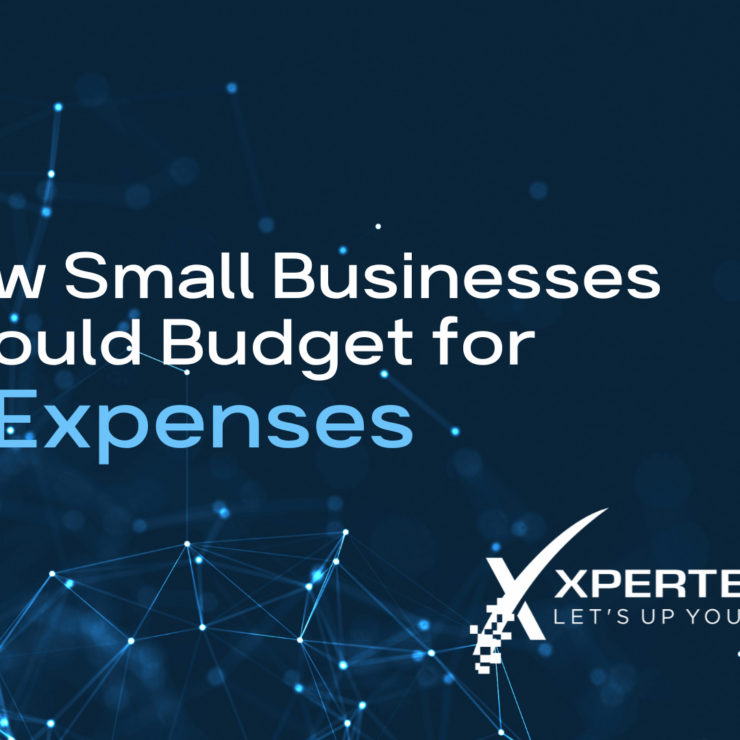How Small Businesses Should Budget for IT Expenses

[Updated for 2025] Building an IT budget is about more than just listing expenses—it’s a balancing act between covering essential needs and investing in technology that can drive growth. While core IT tools keep operations steady, newer innovations like AI and automation offer fresh ways to boost productivity and efficiency.
Yet not every tool is the right fit. Small businesses must be selective, ensuring their IT investments align with business goals. A well-planned budget addresses both the essentials and wise tech choices, preparing your business for today and what lies ahead. Here are some things to include in a budget that covers your needs and positions your organization for growth.
What to Include in Your IT Budget
1. Hardware Replacement
Hardware is foundational, and with AI advancements, staying current is essential. Many AI applications, along with newer software, won’t run on outdated machines. Setting a regular refresh schedule ensures your business has reliable equipment that supports today’s technology, from Windows 11 to AI tools requiring specialized hardware.
Related: Prepare for Windows 10 End of Life with a Strategic Hardware Refresh
2. Software Subscriptions and Licenses
Standard software subscriptions—such as Microsoft 365, line-of-business software, and communication tools—are ongoing costs. Adding tools for automation, like Microsoft Power Apps and Copilot, may require specific licensing, so include these in your budget. Regular software audits help avoid unnecessary expenses and ensure you’re not paying for unused licenses, keeping software costs in check.
3. Cybersecurity and Compliance
Managing risk is essential to keeping your business secure. Cybersecurity requires a balanced investment in both traditional defenses and newer AI-driven solutions that improve threat detection. As technology use grows, particularly with AI and automation, strengthening your cybersecurity posture becomes an increasingly critical part of the budget.
4. Network Maintenance
Your network is the backbone of all technology, from daily operations to advanced applications. Proactive maintenance keeps everything running at its best, whether you’re using on-premises systems, cloud services, or a mix of both. With regular oversight, you’ll optimize performance, manage costs, and ensure security—keeping AI, automation, and other tools working seamlessly.
5. Data Backup and Recovery
Data backup and recovery are essential to maintaining business continuity. A solid recovery strategy ensures that, beyond protecting information, you have a plan in place to quickly restore operations if disruptions occur. By budgeting for reliable backup solutions, you can minimize downtime and safeguard critical data, keeping your business resilient against unexpected events.
6. Expansion and Project Expenses
Planning ahead is key to managing growth. Consulting with a VCIO helps you pinpoint needed improvements, plan their timing, and project costs. Budgeting for projects like custom Power Apps or automation tools, along with network upgrades, supports efficiency and growth. As your business expands, factor in future staffing or new locations to keep your tech infrastructure aligned with your goals.
7. Employee Training
Effective use of new tools depends on skilled employees. Include training in your budget so your team stays current with best practices, cybersecurity awareness, and efficient tech use. Account for training time, as it may impact productivity in the short-term but ultimately boosts efficiency and reduces tech issues.
8. Voice Communications and Meeting Technology
Quality communication tools are essential, especially for remote and hybrid teams. Upgrading to Microsoft Teams Phone and setting up a Teams Room—complete with a video bar, high-quality microphones, and displays—ensures everyone can see, hear, and fully participate in meetings. This setup minimizes distractions and makes collaboration feel seamless, allowing your team to stay focused on the conversation rather than technical issues.
Related: Microsoft Teams Phones Implementation Takes Phone Worries Off CFO’s Radar
9. Scalable IT Support
Choosing managed or co-managed IT services provides a predictable cost structure for your IT budget, covering a full range of expertise without the need to hire, train, and retain staff. With fully managed services, your provider handles all aspects of IT, offering a stable, consistent solution. For companies with an in-house team, co-managed IT supplements your staff, filling in skill gaps, covering PTO, and preventing service disruptions. Both options help avoid unexpected expenses and ensure your IT needs are reliably met.
10. AI and Automation Planning
AI and automation are not standalone investments—they integrate into many areas of IT, from hardware and software to training and cybersecurity. Budgeting for these technologies requires a big-picture approach, covering compatible hardware, specialized licensing, and ongoing training. When AI and automation are woven into your overall IT strategy, each investment supports productivity and business growth.
Related: How to Find Opportunities for Business Automation
Pull It All Together with a VCIO
These budget considerations form the foundation of a tech-forward, efficient business. Whether developing an AI strategy or planning routine maintenance, a Virtual Chief Information Officer (VCIO) can help you integrate all elements, balancing foundational needs with future-focused technology.
IT Budgeting Guidance with Managed IT Services
At XPERTECHS, our VCIO services ensure that your IT budget doesn’t just meet today’s needs—it’s built for tomorrow’s opportunities. If your IT strategy isn’t opening doors to innovation, we’re here to help.
Reach out today to explore how we can support your goals.
